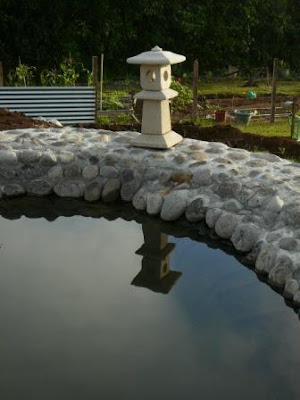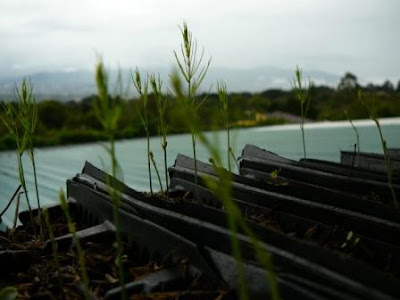I'd really like to call this our water garden, because that's what it is. A pond with plants and fish in it is an extension of the land garden, just as beautiful, and as enjoyable. But water garden is a bit long and pretentious sounding, so, for the sake of brevity, I'll just call it a pond.
When I was a teenager, living in Alexandria, Virginia, we had a small pond in the middle of our brick patio. It started out with goldfish, and then we added water lilies and water hyacinth, and it became something extra special. A couple of times we drove out to Adamstown, Maryland, to visit the Lily Pons Water Gardens to buy fish and plants ( http://www.lilypons.com/contactus.asp ). We didn't realize it at the time, but Lily Pons is one of the premier pond supply companies in the world. It was a really neat place to visit. Dad loved the goldfish, and learned that he could fatten them up with houseflies. One summer he had a hernia operation and was laid up at home with nothing to do for a month. That's when he got out the flyswatter, swatted and fed the flies to the fish, and tried to see how much he could get those goldfish to grow in one month. He got so into it that he began putting out sugar to attract the flies. He had a clipboard with a tally sheet where he made a hash mark for each fly killed. I think his record for flies killed in a day was over 80. So, here was this high-powered Washington lawyer spending his summer killing flies and feeding them to the goldfish. Go figure.
Many years later when we lived in Clemson, South Carolina, Maria and I installed one of those rigid plastic ponds that we purchased at Lowe's. It held about 150 gallons and was about eight by four feet in size. We quickly fell in love with it, and our only regret was that we didn't get a bigger one.
So when we retired to Costa Rica one of the of the first things we decided to do was to build a much larger pond. It's 30 feet long by 15 wide. It's size and location came about, in part, by accident. Our lot is on an incline, and even before the house was finished we had problems with rainwater runoff. The municipality required us to channel our downspouts into an underground cavern filled with boulders. This has worked pretty well. But until we had trees, shrubs, and grass, there was a lot of runoff from the dirt around the house, and also, we built a large driveway, which channeled water to the lower part of our lot, and then down onto two neighboring lots. Whenever we got a big downpour, it looked like a river running down past our house. So, we hired a backhoe guy to make a rainwater catchment basin as a temporary measure. The basin became an eyesore, and one day when we were talking about how we could change it, it dawned on us that this would be the perfect place for our pond.
 |
| Rainwater catchment basin during a heavy downpour. |
We also decided to harvest rainwater from our roof and driveway, channeling the water either directly to the pond, or to an underground storage tank, which would serve as a reserve to refill the pond between rains and during the 5-month-long dry season. We went with a 1,100-gallon tank. For the installation of the tank, see the blog entry for November 27, 2010.
We had heard that there was a professional pond builder in Costa Rica, but after some discussion Maria and I decided to hire a local, Alexis Sanchez, to do the job. Alexis has extensive experience as a builder, is a jack of all trades, and has built a couple of small ponds with fountains. Also, he had already built two fences for us and we knew he was a hard worker, honest, conscientious, and reasonably priced. Alexis first built our water harvesting system. After that he built a temporary fence dividing our property in two, so our dogs wouldn't get into the pond. Also, he rewelded my 34-year-old wheelbarrow, fixed our electric gate, installed a door lock in the house, and then went on to build a patio at one end of the pond, a seven-foot high wall (as a windbreak), and a small structure to house our electric water pump. The whole process took six weeks, but he really did a lot of things other than the pond.
 |
| Alexis and helper transforming the rainwater catchment basin |
Alexis, my wife, and I all agreed that we wanted a plastic liner anchored around the edges with cement and river-stone, we wanted a two-level pond, the shallow end being at least a foot deep, and the deep end between two and three feet deep, and we wanted a small waterfall. We also agreed, after some discussion, that it should not have a drain pipe at the bottom, but would have an overflow pipe at the top. In the event we ever wanted to drain the pond, we would have to use a pump.
It took Alexis and two helpers three days to modify the original rainwater catchment basin into the approximate dimensions we wanted. Next Alexis went to San Jose to buy the liner, which I had told him had to be at least 30 mil thick. He returned with a roll of polymer which was only 8 mil thick, saying that this was the thickest plastic available in Costa Rica. I was disappointed, but we agreed to put several layers down on top of each other. When we spread it out, we discovered that it was more than long enough, but was not quite wide enough to do the job. This resulted in further discussion, and an eventual plea for advice with the Yahoo ponders group ( http://groups.yahoo.com/group/PONDERS_INTERNATIONAL/ ). I quickly received an email from a professional pond builder back in the States warning me that overlapping liners (in order to fit our width) would be a critical mistake. He also strongly encouraged me to purchase EPDM liner 45 mils thick. Further discussion followed, and we finally agreed to make the pond about four inches shallower, which would bring the width in enough that we wouldn't have to use overlapping liners.
 |
| Covering the dirt with sand to protect the liner |
As for using EPDM, this would have resulted in halting the construction for at least a month while we waited for the EPDM to be imported from the States. Maria said she'd go nuts if she had to look at that muddy hole in the ground for another month, so that settled that -- we went ahead with what we had. All this explanation may sound too detailed to some of you, but believe me, this is the short version.
 |
| Anchoring the liner with cement and river stone |
One of the last things Alexis did was to build the waterfall. As you can see from the picture, it is shale, placed horizontally with cement. It has a horizontal two-inch pipe hidden at the top with a row of holes drilled in it, to give the cascade adequate width.
 |
| Maria & her sister admiring the pond (windbreak at left, housing for pump at lower right) |
The pond is now finished, except for some landscaping around the outside of the cement and river stone. But in another week or two, we will hopefully have this finished.
 |
| Pagoda |
We got our fish and snails at local aquarium stores. We have small-to-medium-sized kois of all colors that have grown by leaps and bounds in the three short weeks they have been in the pond. We also have several kinds of small goldfish, and also several swordtails. The smallest goldfish and the swordtails hang out in the shallow end; the kois in the deep end.
Getting plants was quite an adventure. Water hyacinth were the easiest -- we got them at a local nursery. We bought watercress at the local supermarket and rooted it in some damp soil. We went to a couple of places where we were told we could get "lirios de agua (water lilies)," but each time we discovered they were only water hyacinth. We have some kind of small plant we got from a stream. Not sure what it is. Water lettuce and duckweed we got from Barry Biesanz in Escazu ( Biesanz Woodworks -- http://www.biesanz.com/ ). For our one water lily we had to drive all the way to Alto la Palma, which is halfway between Puriscal and Parrita (on the Pacific coast). The water lily, along with some duckweed and water pickerel, was given to us by Mariel Castanada. She and her husband Brian took us on a tour of their beautiful resort/housing development ( http://www.altigua.com/ ). If anyone is considering moving to Costa Rica, their development is definitely worth checking out. We were able to make contact with both Barry and Mariel through the Yahoo Costa Rican Gardening group ( http://groups.yahoo.com/group/crgardening/ ).
 |
| Waterfall (on island in foreground is statue of monkey contemplating a human skull) |
Our frogs we caught with a net at a local pond. We're not sure what kind they are. We got six, and two of them died. One of the survivors is serenading us in the evenings. All of the fish and snails seem to be healthy. The sides and bottom of the pond are covered in algae, but the water is very clear.
And . . . we just LOOOOOVE our pond!!!
Happy gardening!











